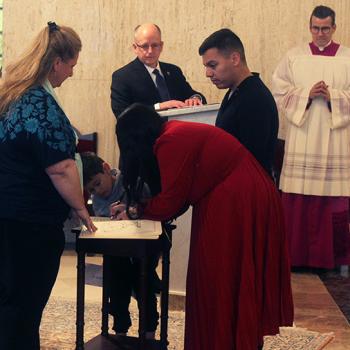Christianity has a long history of contemplative practice, but many scholars and spiritual teachers within the faith recognize that in the centuries immediately preceding and following the Reformation, the church (at least in the west) largely lost its contemplative heart. Theologian Robert Davis Hughes III, for example, wrote that after the Reformation, "spirituality, especially the more contemplative or mystical side, is marginalized as dangerous to the forces of good order" (Hughes, Beloved Dust, p. 16).
The Reformation, on one level, was a fight over authority: is the leadership of the church the final word on earthly religious authority, or is the Bible? In such a debate, contemplatives and mystics, who find at least some sense of authority in the authenticity of their own experience, are indeed likely to be seen as "dangerous to the forces of good order"—by all parties! And if the marginalization of contemplation began in the church, the rise of science and modernity meant that the spirituality of inner experience became even more suspect. Is it any wonder that dictionaries began defining "mysticism" as, for example, "self-delusion or dreamy confusion of thought" (OED)?
While the late 19th century saw some resurgence of interest in the interior dimension of spirituality, thanks to the work of psychologists like William James or theologians like Friedrich Von Hügel, the 20th century will probably been seen in centuries to come as the age of the renaissance of contemplation in the west. But our age is the also the age of interfaith encounters, indeed, the first era of human history when so many different faith and wisdom traditions have become so readily accessible even to the average person, at least in urban centers (and more recently, through cyberspace). What is interesting to consider is the ways in which these two spiritual megatrends—the rebirth of Christian contemplation in the west, and the rise of interfaith dialogue and encounter—seem to be interrelated.
Let me offer a bit of anecdotal evidence.
- Several years before entering the Trappist monastery, Thomas Merton (while still a graduate student at Columbia) befriended an Indian scholar named Mahanambrata Brahmachari. As recounted in The Seven Storey Mountain, Merton was bemused when his Hindu friend insisted that he read Augustine's Confessions along with The Imitation of Christ. "He seemed to feel as if he were in possession of a truth that would come to most Americans as news," wrote Merton. "As if there was something in their own cultural heritage that they had long since forgotten: and he could remind them of it" (The Seven Storey Mountain, p. 198).
- But Brahmachari was hardly the only non-Christian to influence the spiritual life of a Christian contemplative. Tilden Edwards, the Episcopal priest who founded the Shalem Institute for Spiritual Formation, did so after spending two months on retreat under the spiritual guidance of the Buddhist Rinpoché Tarthang Tulku. Edwards recounts in his book Living Simply Through the Day how he asked the Rinpoché to be his teacher, only to get this surprising response: "I am your Tibetan priest-friend, Tilden. We are priest brothers. You don't need to be a Buddhist student. You can learn everything I have to offer and use it within your own tradition. There is nothing to gain by crossing over. It is all there available as a Christian" (Living Simply Through the Day, p. 29).
- Meanwhile, other Christians took the radical step of travelling to lands far from their home so that their Christian faith might be illuminated by the wisdom of other paths. Bede Griffiths, Henri Le Saux (Abhishiktananda), and Sara Grant were three European Catholics who journeyed to India, becoming friends and students of Hindu sages like Ramana Maharshi and Ram Swarup—and adopting many Hindu customs and practices, while retaining their core identity as Christians.
- Centering prayer—the method of Christian contemplation popularized by Trappist monks Basil Pennington, Thomas Keating, and William Meninger—while anchored in the Christian teachings of the desert fathers and mothers and the writings of the author of The Cloud of Unknowing, also was very much intended, at least in its early years, as a western alternative to eastern practices such as Zen or T.M.—which has, ironically, led to it being denounced by some ultra-conservative Christians for being too "eastern" a form of meditation!
Would the Christian contemplative renaissance have happened as fully or as quickly without the kind of inter-religious cross-fertilization that these examples exemplify? Of course, there's no way to tell. But perhaps it makes sense to say that Christians today who find meaning and value in contemplative spirituality really do owe a debt of gratitude to many non-Christian spiritual teachers, who, instead of seeking to convert Christians to their faith, instead helped Christians to rediscover the treasures in their own.
12/2/2022 9:10:33 PM




